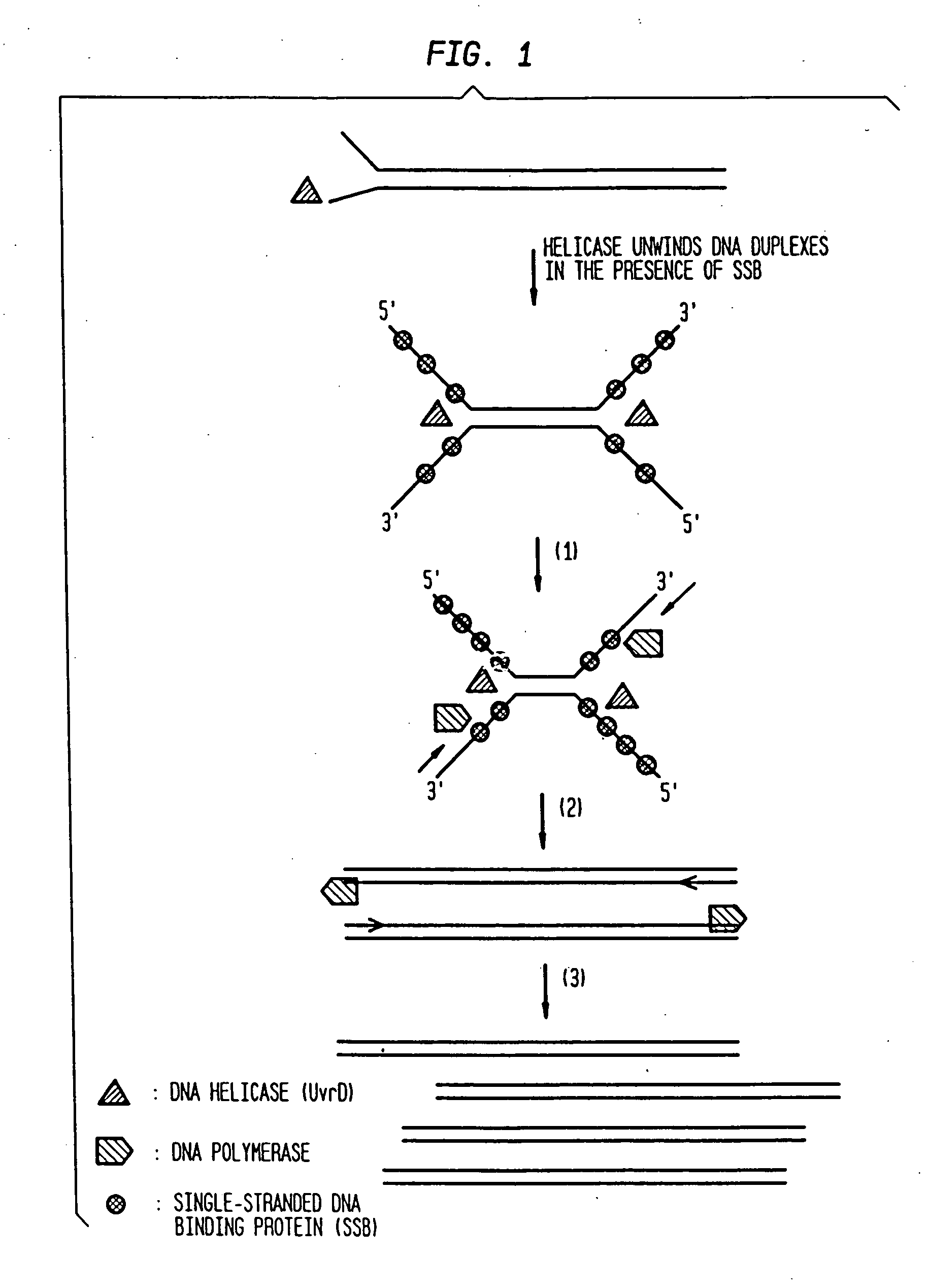Helicase-dependent amplification of nucleic acids
a technology of helicase and nucleic acids, applied in the field of helicase-dependent amplification of nucleic acids, can solve the problems of ineffective sda amplifying long target sequences, limited starting materials for tma and 3sr, and limitations of amplification methods mentioned above, and achieve the effect of effective activity
- Summary
- Abstract
- Description
- Claims
- Application Information
AI Technical Summary
Benefits of technology
Problems solved by technology
Method used
Image
Examples
example i
Cloning and Purifying UvrD Helicase and its Accessory Protein MUTL
1. Cloning the Genes Encoding UvrD Helicase and MutL Protein.
[0204] Genes encoding E. coli helicase II or UvrD helicase (Swissprot Accession No.: P03018) and its accessory protein E. coli MutL protein (Swissprot Accession No.: P23367) were cloned using the Impact™ system which leads to a C-terminal translational fusion of a bifunctional tag consisting of the S. cerevisiae VMA intein and a chitin-binding domain (New England Biolabs, Inc. (Beverly, Mass.)). This protein purification system utilizes the DTT-inducible self-cleavage activity of a protein splicing element (termed an intein) to separate the target protein from the affinity tag (chitin binding domain). Vent® DNA polymerase was used to amplify UvrD gene from E. coli K12 genomic DNA using primer 5A (5′ GGTGGTACCATGGACGTTTCT TACCTGCTC 3′ (SEQ ID NO:1)) and primer 3A (5′ GGTGGTGCT CTTCCGCACACCGACTCCAGCCGGGC 3′ (SEQ ID NO:2)). The mutL gene was amplified from E...
example ii
Method of Amplification of a Nucleic Acid Duplex Target
[0208] As a model system for Helicase Dependent Amplification, a synthetic DNA duplex was used as template in the HDA reaction. This example illustrates amplification of this DNA duplex using the UvrD HDA system. A method for template denaturation, primer annealing and extension is described below.
[0209] Thirty five μl of reaction Component A was made by mixing 10 μl of 5×HDA Buffer A (175 mM Tris-HCl (pH7.5), 5 mM DTT), 0.5 μl of 70-bp DNA template derived from top oligodeoxy-nucleotides (2 μM; 5′ TGGCTGGTCACCAGAGGGTGGCGCGGAC CGAGTGCGCTCGGCGGCTGCGGAGAGGGGTAGAGCAGGCAGC 3′ (SEQ ID NO:5)) and bottom oligodeoxynucleotides (2 μM; 5′ GCTGCCTGCTCTACCCCTCTCCGCAGCCGCCGAGCG CACTCGGTC CGCGCCACCCTCTGGTGACCAGCCA 3′ (SEQ ID NO:6)), 1 μl of 5′-primer (10 μM; 5′ CATGTTAGGTTCTATGGATCGAGTCTGGCTGG TCACCAGAGGG 3′ (SEQ ID NO:7)), 1 μl of 3′-primer (10 ′M; 5′ TCCCTTAGAGGTCACATTGGATCGAGTCGCTGCCTGCTCTACCCC 3′ SEQ ID NO:8)), 10 μl of four dNTPs (2 mM...
example iii
Amplication of a Specific Sequence from Plasmid DNA by HAD
[0210] To test whether HDA can be used to amplify a specific target sequence from a DNA template, we used two pUC19 / M13 universal primers, primer-1224 and primer-1233, to amplify a 110-bp sequence from a 2647-bp DNA plasmid, pAH1 (FIG. 15 (SEQ ID NO:9)) using the UvrD HDA system. Primer-1224 and primer-1233 are commercially available and their sequence can be obtained at the company (New England Biolabs, Inc., (Beverly, Mass.)). The amplification scheme is outlined in FIG. 3.
[0211] Two acetate-based reaction buffers were pre-made: 10×HDA Buffer A contains 350 mM Tris-Acetate (pH7.5) and 100 mM DTT; 10×HDA Buffer B contains 10 mM Tris-Acetate (pH7.5), 1 mg / ml BSA, and 90 mM Magnesium Acetate. The HDA reaction Component A was set up by combining: [0212] 5 μl 10×HDA Buffer A [0213] 1.5 μl of 23 nM AhdI-cleaved pAH1 plasmid [0214] 1 μl of 10 μM primer-1224 [0215] 1 μl of 10 μM primer-1233 [0216] 2 μl dNTPs (10 mM) [0217] 1.5 μl...
PUM
| Property | Measurement | Unit |
|---|---|---|
| pH | aaaaa | aaaaa |
| pH | aaaaa | aaaaa |
| temperature | aaaaa | aaaaa |
Abstract
Description
Claims
Application Information
 Login to View More
Login to View More - R&D
- Intellectual Property
- Life Sciences
- Materials
- Tech Scout
- Unparalleled Data Quality
- Higher Quality Content
- 60% Fewer Hallucinations
Browse by: Latest US Patents, China's latest patents, Technical Efficacy Thesaurus, Application Domain, Technology Topic, Popular Technical Reports.
© 2025 PatSnap. All rights reserved.Legal|Privacy policy|Modern Slavery Act Transparency Statement|Sitemap|About US| Contact US: help@patsnap.com



